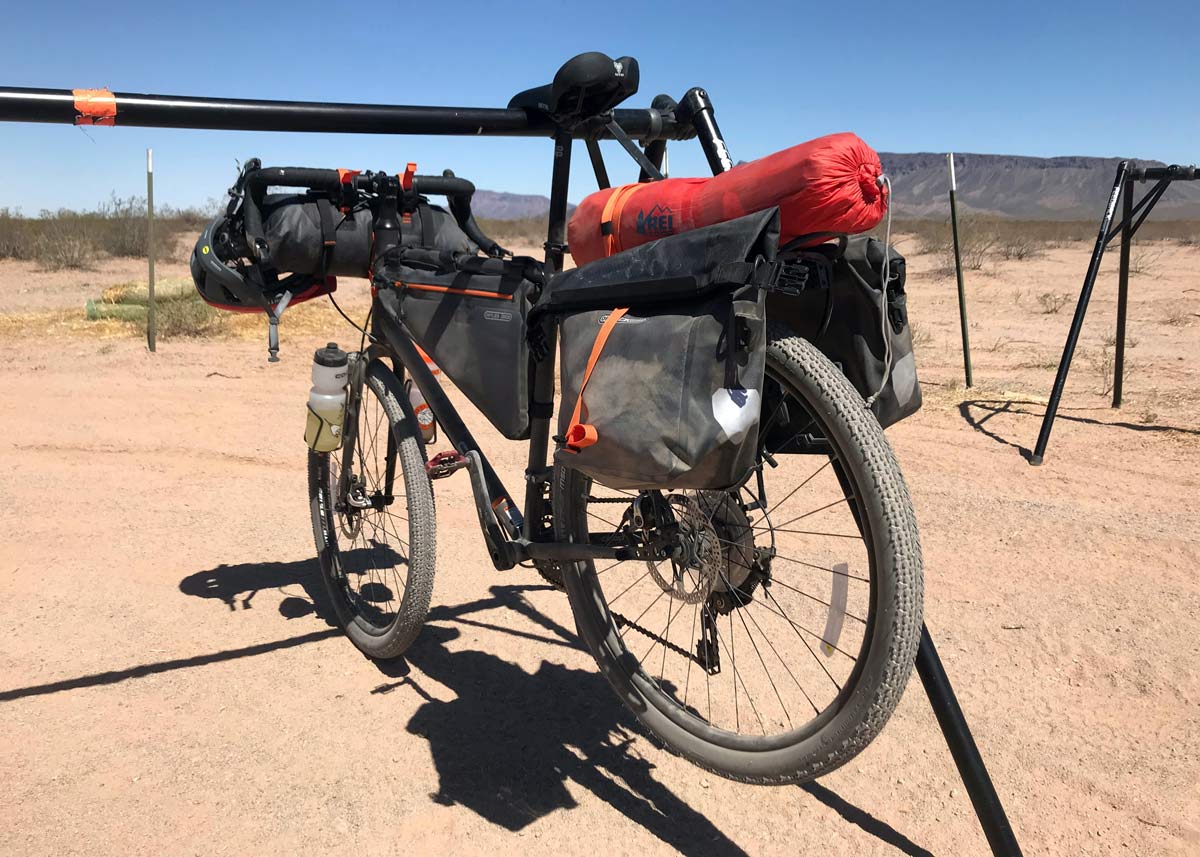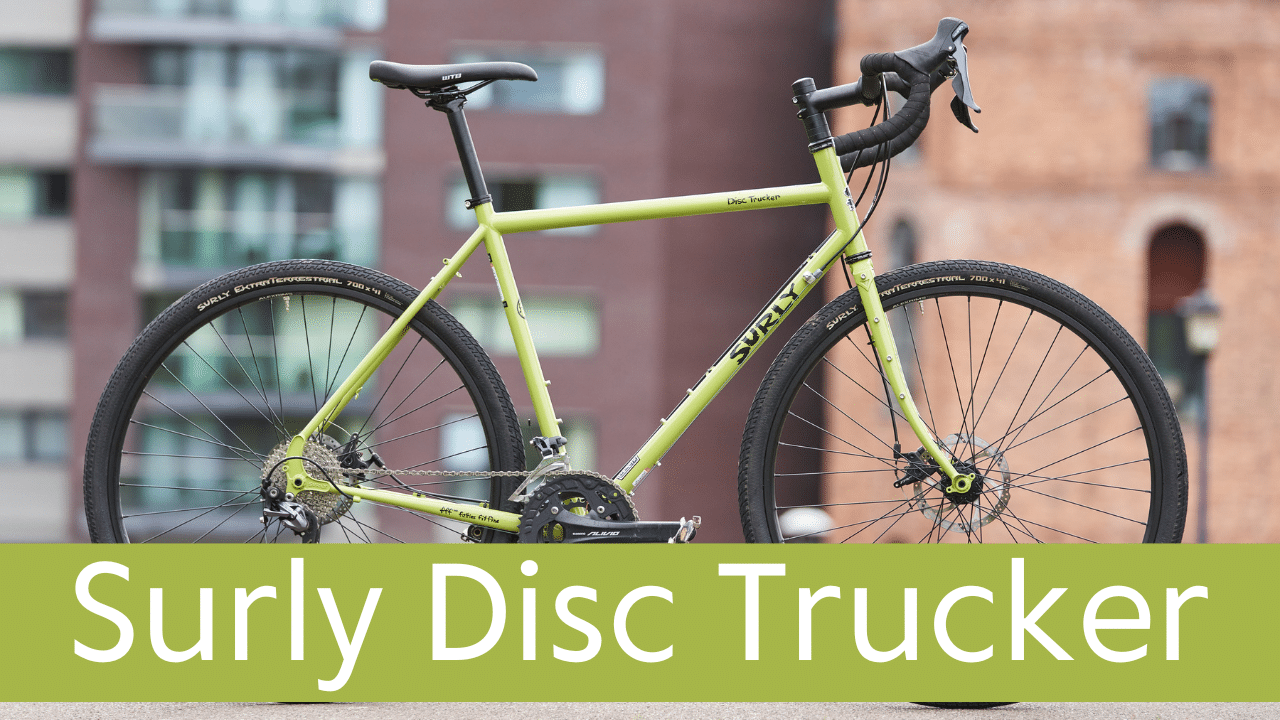Updated: 17th March 2024
The question of whether a gravel bike is suitable for longer bicycle tours receives a definitive yes. However, before you rush to purchase a gravel bike, it’s essential to consider several factors to ensure it meets your needs and preferences.
Are gravel bikes good for touring?
A good number of gravel bikes out there are primed and ready for touring adventures, but let’s not paint them all with the same brush. Diving into the gravel bike scene requires a bit of a detective’s eye for detail, particularly when it comes to bike geometry. It’s this clever design that dictates how stable, comfortable, and gear-friendly your bike will be.
Build quality, too, plays a starring role in ensuring your ride feels just right, especially when loaded up for touring. And then there’s the gear saga – gearing options vary widely among gravel bikes, with some offering a more limited range than you might need for varied terrain.
Indeed, not every gravel bike is cut out for the touring life, and recognizing the stars from the understudies in the gravel bike world is key to setting off on your next grand tour with confidence.
Gravel bikes have surged in popularity for a good reason. They offer the versatility to venture further, exploring off-the-beaten paths as well as paved roads. This adaptability makes them an appealing choice over traditional touring bikes for many cyclists.
But before diving into the differences between touring and gravel bikes, let’s address a crucial decision: the type of riding you anticipate. Will your journeys consist mainly of gravel and off-road trails with a sprinkle of pavement, or do you envision sticking to tarmac?
Traditional touring bikes are typically designed for pavement riding and are known for their robust build. Though you can certainly fit gravel tires on a touring bike, which works to some extent, the key distinction lies in the bike’s geometry.
Gravel bikes often feature a more aggressive riding position, akin to cyclocross bikes, which may not be ideal for extended periods in the saddle. Additionally, when equipped with panniers, the handling of a gravel bike might not be as fine-tuned as desired due to considerations like chainstay length and wheelbase, which are critical for a comfortable touring experience.
You might want to consider a modern touring bike!
If you read our article version of this video. You will unveil a treasure trove of “touring bikes” that seamlessly transition into the gravel biking realm. Remember, the line between touring and gravel bikes isn’t strictly defined—it’s more of a gradient worth exploring. Among the bikes featured in our post, you might just find the perfect companion for your upcoming gravel tour!
What is a Gravel Bike? (For Touring)
The realm of gravel bikes suited for touring is fascinatingly broad, introducing us to the subset known as “light-touring bikes.” These machines are the hybrids of the cycling world, blending the agility and adventurous spirit of gravel bikes with the durability and carrying capacity of traditional touring bikes.
Light-touring bikes are designed for the cyclist who yearns for versatility. They are nimble enough to tackle gravel paths and sturdy enough to bear the load of multi-day touring essentials without the heft associated with classic touring bikes. This balance is achieved through thoughtful geometry, material choices, and componentry that cater to both comfort and efficiency over varied terrains.
A gravel bike, often described as the love child of mountain bikes (MTB) and road bikes, is designed to conquer a variety of terrains and surfaces, earning it the nickname “all-road” bike.
These bikes are built for the adventure-seeker who doesn’t want to be limited by the type of ground beneath their wheels.
They combine the rugged capability to navigate trails and gravel paths—though not quite as extreme as those suited for a dedicated mountain bike—with the agility to speed along tarmac roads, offering the best of both worlds.
As the gravel bike market evolves, we see an increasing array of options tailored to specific riding preferences. Some models lean more towards road cycling, with features and designs optimized for speed and pavement performance. In contrast, others inherit more traits from their mountain biking cousins, equipped to handle tougher, more challenging terrains.
there’s a niche yet intriguing category known as lightweight touring bikes, which stands distinct from the “light-touring” bikes primarily due to their construction. These bikes are engineered to be featherlight, often embracing carbon as their material of choice. This choice prioritizes speed and ease of handling over the rugged durability one might expect from a touring bike designed for the long haul.
While carbon’s lightweight nature makes these bikes a delight for covering distances with less effort, it might not be the first pick for those who prize durability above all, especially on unpredictable terrains. I have a soft spot for steel, possibly showing a bit of bias, given its renowned toughness and resilience. Steel has a way of handling the bumps and scrapes of adventurous touring with a steadfastness that’s hard to match.
However, exploring the world of carbon lightweight touring bikes is an adventure in itself. They offer a unique blend of performance and agility that can significantly enhance the touring experience, especially for riders looking to keep the pace up and the load light. While they may not be the traditional workhorses of the touring world, they certainly carve out their own path for those willing to trade a bit of ruggedness for speed and sleekness.
One of the defining characteristics of gravel bikes is their versatility, especially when it comes to bicycle touring. Their geometry is typically more relaxed compared to traditional road bikes, prioritizing comfort for long days of riding. Additionally, they are designed to carry extra gear, making them ideal companions for both short excursions and extensive touring adventures.
In the diverse world of gravel biking, we encounter specialized variants known as “adventure bikes” or bikepacking gravel bikes. Crafted with intention, these bikes are designed specifically for the rigors and rewards of bikepacking journeys. Adventure bikes cater to cyclists who crave the thrill of exploration without sacrificing the practicalities needed for extended off-road adventures.
Another intriguing category is that of drop bar mountain bikes. These bikes merge the robustness of mountain biking with a nod to road cycling’s heritage through their use of drop bars.
These drop bar mountain bikes are lauded for their mountain bike-like DNA, enhancing their ability to navigate through tough, demanding landscapes. This particular niche blurs the traditional boundaries between bike types, underscoring the vast possibilities and adventures that the broader category of gravel bikes can unlock.
What to Consider in a Gravel Bike for Touring
Selecting the right gravel bike for touring involves finding the perfect balance between road and mountain bike features tailored to your riding preferences. Gravel bikes, with their versatility, excel in fulfilling the roles of a touring bike, especially for those planning to traverse primarily gravel paths. However, several key aspects warrant close attention.
Geometry
The geometry of the bike is paramount. It’s advisable to steer clear of cyclocross bikes for touring purposes due to their race-oriented geometry, which includes shorter chainstays, wheelbase, trail, front center, and head tube length, significantly affecting the ride.
Consider, for example, the comparison between the Basso Palta —a model celebrated for its aggressive and speedy attributes—and the Kona Rove, which is arguably more conducive to relaxed touring. For the sake of comparison, we’ll focus on medium-sized frames. The Kona Rove emerges as the more touring-friendly option, with the Basso Palta displaying characteristics more aligned with road cycling.

Ideal touring geometry would feature a longer wheelbase for stability when loaded, extended chainstay length to prevent heel strike from rear panniers, a longer front center to avoid toe overlap with a loaded bike, and a lower bottom bracket height for a lower center of gravity.
| Basso Palta | Kona Rove | |
| Category | Aggressive/Race Gravel Bike | Touring Gravel Bike |
| Stack | 563 mm | 588 mm |
| Reach | 373 mm | 388 mm |
| Stack to Reach Ratio | 1.51 (Surprisingly Upright) | 1.52 |
| Bottom Bracket Drop | 65 mm | 72 mm |
| Bottom Bracket Height | 286 mm | 267 mm |
| Chainstay Length | 425 mm | 435 mm |
| Front-Center | 605.5 mm | 623 mm |
| Wheelbase | 1022 mm | 1048 mm |
| Trail | 80 mm very high | 63.9 mm mid/neutral |
Check out this link to the Bike Insights search I did comparing these two bikes and you will see the differences in geometries.
The geometry comparison illustrates that the Kona Rove offers a more upright riding position and a wider stance capable of managing heavier loads more effectively than the Basso Palta.
Expanding on these real-world examples, let’s contrast the touring-suitable Kona Rove with the geometry of a traditional touring bike, such as the Surly Disc Trucker. The Surly’s geometry further enhances comfort and gear accommodation, featuring even longer chainstays and wheelbase, along with a significantly taller head tube for a more upright position.

Also check out the link to this comparison on Bike Insights here.
When searching for a gravel bike that doubles as a touring bike, the objective is to identify a model whose geometry strikes a harmonious balance between the aggressive stance of race-oriented gravel bikes and the comfort-focused design of traditional touring bikes.
This blend of characteristics ensures a bike that’s not only enjoyable to ride on varied terrains but also practical and comfortable for long-distance adventures.
Gearing Considerations for Touring on a Gravel Bike
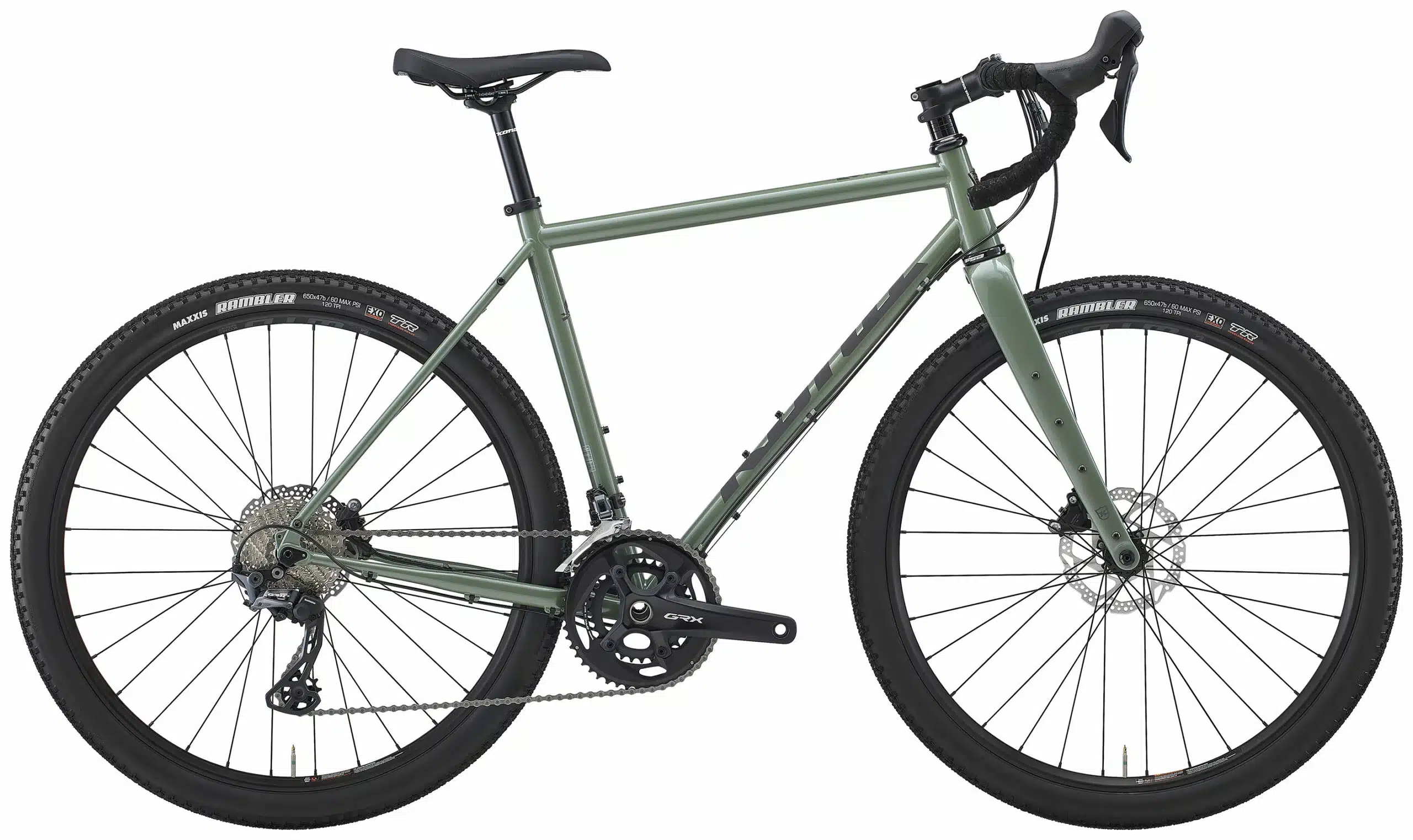
Gearing is a pivotal consideration when selecting a gravel bike for touring. It’s essential to anticipate the terrain you’ll be navigating. If your journey involves climbing numerous hills with a loaded bike, possessing a broad spectrum of gears becomes indispensable.
This variety allows for comfortable ascents and efficient travel over flat terrains or downhills, though the importance of high-speed gearing diminishes in a touring setting.
It’s crucial to recognize that many gravel bikes currently available may not offer the appropriate gearing for steep climbs under heavy loads, presenting a significant limitation.
Therefore, verifying the bike’s gear range and suitability for your intended routes is a critical step before committing to a gravel bike for touring purposes.
Understanding Gear Range

Traditional touring bikes often feature a triple chainring setup, offering a gear range from 18″ to 117″. This range implies that the lowest gear (or “granny gear”) provides 18 inches of travel per pedal revolution, ideal for climbing.
For gravel bikes intended for loaded touring, a lower gear inch value is preferable, with 20″ being an ideal sweet spot and anything above 25″ in the lowest gear generally considered less than optimal for peak performance.
Finding a gravel bike that offers a lowest gear of 18″ can be challenging, which is why only a select number of gravel bikes are truly ideal for touring purposes.
Many models feature a lowest gear around 25″, which may not suffice for touring needs, particularly on steep mountain trails while carrying bikepacking gear.
From personal experience, even with a bike labeled as suitable for “touring/gravel/adventure,” a lowest gear around 25″ can make steep ascents challenging.
Calculating Gear Range
To calculate a bike’s gear range, multiply the tooth count of the smallest front chainring by the largest rear cog. For instance, the Kona Rove LTD, equipped with a Shimano GRX 810, 31/48t crankset, and a Shimano 105 11-34t 11-speed cassette, represents a gearing setup more conducive to touring compared to other models.

Using a Gear Inch Calculator—which accounts for tire size and width—helps visualize this range through a graph.
This method simplifies the process of determining whether the gear range of the bike you’re considering is well-suited for touring.

I recommend visiting a website such as 99Spokes.com and looking up the bike you’re interested in. Scrolling down untill you find the specs section (build, groupset and wheels) Enter the required details of the bike into bikecalc.com to generate the gear inches results and proceed from there. Check if the granny gear is below 25 inches, or ideally, around 18 inches.

For the Kona Rove LTD, the calculation would be 48×11 for the highest gear, yielding 116 gear inches, and 31×34 for the lowest gear, resulting in 24 gear inches.
Ideal Gear Ratios for Touring
When assessing gear ratios for adventure riding and touring on a drop bar gravel bike, a 1:1 ratio is highly effective. Such low gears enable the rider to tackle steep inclines with a loaded bike more comfortably, preserving leg strength for long-distance journeys. A desirable gear range spans from 420% to 500%.
For the Kona Rove LTD, the gear range is determined by dividing the largest gear inches by the smallest and then multiplying by 100.
In this example, 110.92/23.35×100=475.03%, indicating a gear range difference of 475.03% between the smallest and largest gears. This range highlights the bike’s capability to handle diverse terrains and loads, making it an excellent choice for touring.
Gearing is a fundamental aspect to consider when selecting a gravel bike for touring. The right gear range can significantly affect your ability to climb hills and cover long distances efficiently.
By understanding and calculating gear inches and ratios, you can choose a bike that matches your touring needs, ensuring a more enjoyable and feasible adventure riding experience.
Other Essential Features for Touring Gravel Bikes
When choosing a gravel bike for touring, geometry and gearing emerge as the primary considerations.
Additionally, a bike frame equipped with eyelets for mounting both rear and, potentially, front racks for panniers is essential, marking a significant distinction from bikepacking setups.
While not mandatory, the inclusion of fender mounts and cargo cage mounts also adds value.
The material of the bike frame plays a crucial role. Traditionally, touring bikes are crafted from steel due to its durability and capacity to support heavy loads, despite its weight.
Modern advancements have led to lighter steel frames, often complemented by carbon forks in higher-end steel gravel bikes. Alternatives like carbon, aluminum, or titanium are available, but for the quintessence of traditional touring, steel stands unparalleled in its suitability.
While wheels, handlebars, and other components might seem less critical, they still contribute to the bike’s overall performance and comfort. Handlebars with a flare are increasingly popular on gravel bikes, offering additional comfort for extended rides.
The choice between mechanical or hydraulic disc brakes is another consideration; many argue that mechanical brakes are preferable for touring due to their simpler roadside serviceability.
Comparing Touring Bikes and Gravel Bikes
After delving into the specifics of geometry and gearing for both touring and gravel bikes, it’s clear that distinctions extend beyond these elements. Here’s a breakdown of their differences:
Touring Bikes

- Gearing: Optimized for tackling the steepest hills while maintaining a respectable pace on flat terrains.
- Material: Predominantly built from steel, offering durability and a more forgiving ride when heavily loaded or traversing global terrains.
- Wheels: Typically feature around 36 spokes, enhancing wheel strength for the demands of touring.
- Design Focus: Engineered as a utility vehicle prioritizing comfort over speed for extended journeys.
- Features: Always equipped with eyelets for mounting racks and fenders. Models like the Surly LHT even include chainstay mounts for spare spokes.
- Geometry: Designed with less aggressive angles to ensure greater comfort during long rides.
- Tire Compatibility: Capable of accommodating wider tires than road bikes, though some gravel bikes may support even wider options.
- Ride Quality: Touring bikes often perform best when loaded; riding them without cargo can significantly alter their handling.
Gravel Bikes

- Versatility: Gravel bikes are designed to be highly versatile, not limited to a single type of riding, making them almost an all-in-one bike option.
- Adventure Potential: Offer a wider variety of adventure locations, including off-road capabilities.
- Material Variety: Constructed from various materials, including steel, aluminum, carbon, and titanium, catering to different preferences and needs.
- Tire Width: Generally support wider tires designed for gravel, which roll efficiently on both roads and off-road conditions.
- Geometry: Can feature more aggressive geometry; it’s crucial to compare with traditional touring bikes to understand the differences.
- Weight: Often lighter than traditional touring bikes, enhancing their appeal for riders looking for a less burdensome option.
- Geometry Balance: The best gravel bikes strike a balance between the elongated geometry of touring bikes and the aggressive stance of road bikes.
- All-Rounder: Ideal for cyclists seeking a bike that excels in a variety of settings, making it the perfect all-rounder.
These distinctions highlight the unique strengths and intended uses of each bike type, read the full comparison here.
Best Gravel Bikes For Touring
Now let’s take a look at some of the best gravel bikes for touring. In no particular order, these are some of my favorites. They offer a comfortable geometry, the ability to mount for racks and panniers, and are just all-around adventure machines!
These bikes are good for road and off-road touring. Which is what I assume you will mostly want to ride. Some of them are technically categorized as touring bikes or adventure touring bikes.
My belief is that they are also gravel bikes at heart as some have gravel-specific drivetrains and they have a place in this category.
Kona Rove LTD
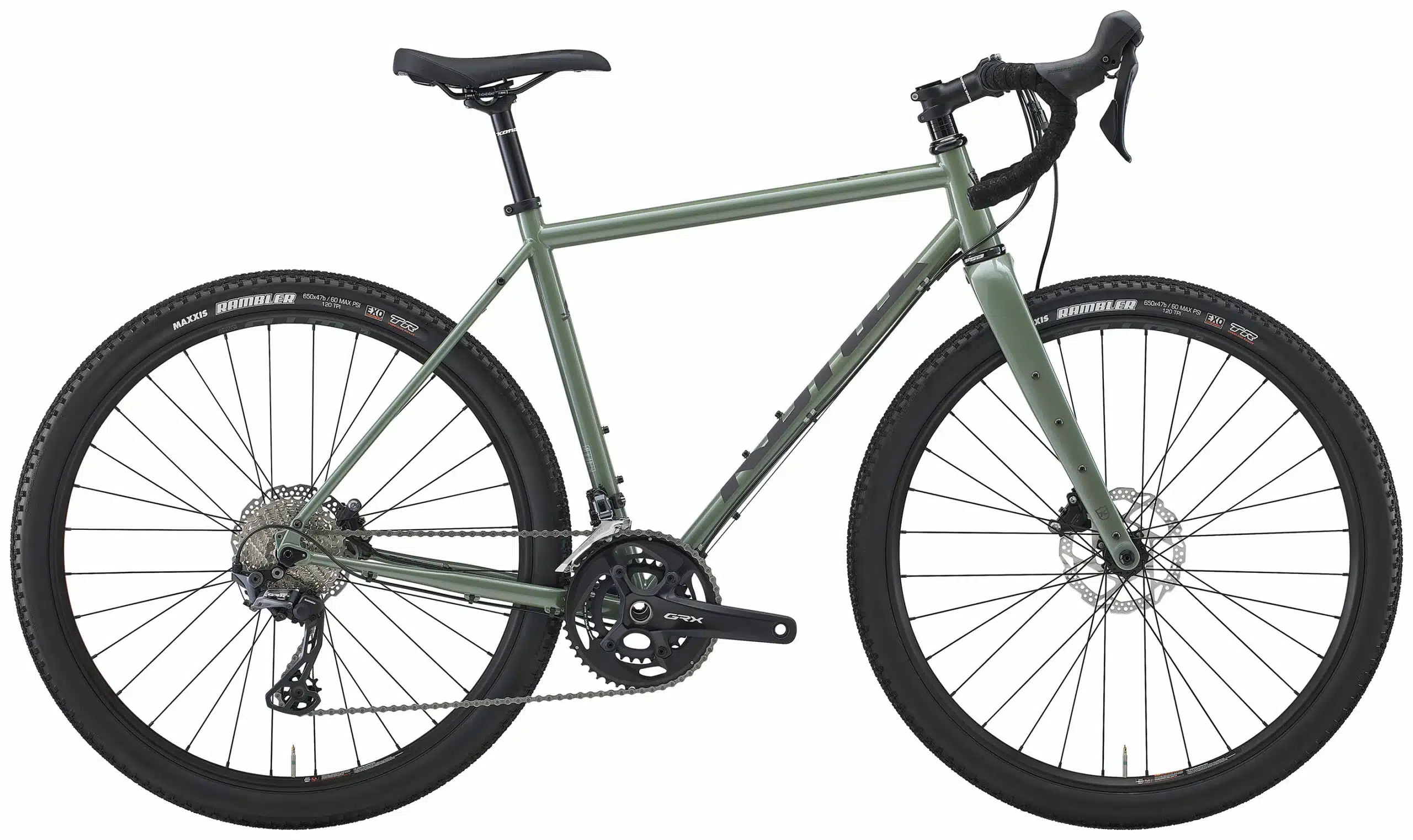
As highlighted, the Kona Rove excels as a gravel bike tailored for touring. It’s challenging to find alternatives that embody a seamless blend of touring and gravel biking characteristics, yet are fundamentally designed for touring. An example is the Rove’s older sibling, the Sutra, which I personally favor for my rides.
Despite the appeal of gravel bikes, they often fall short as complete substitutes for traditional touring bikes. However, there are commendable choices available in the market, similar to the Rove, which also doubles as an excellent commuter bike.
Marin Four Corners
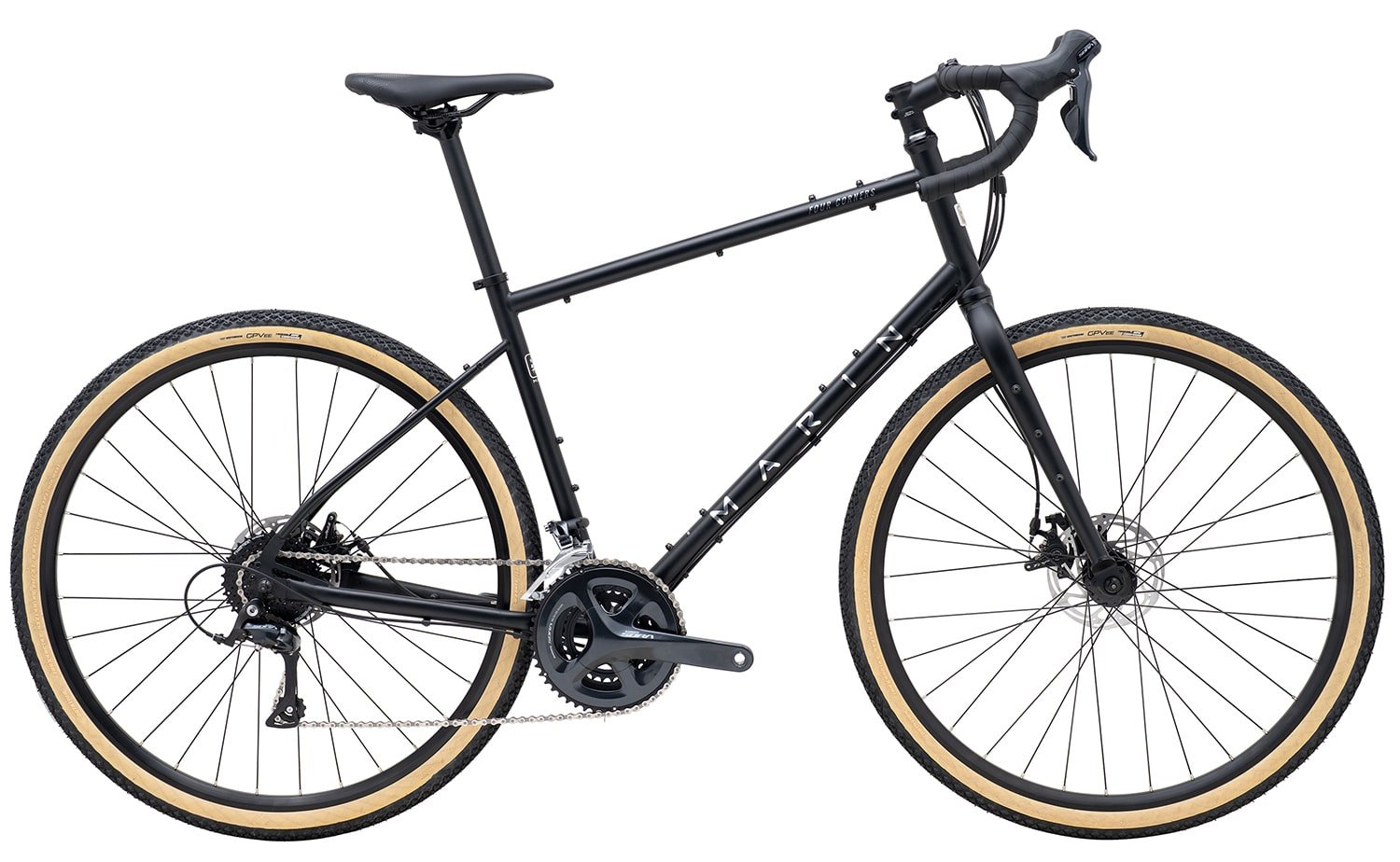
If you’re in the market for an affordably priced gravel/touring bike made from full chromoly steel, the Marin Four Corners Bike stands out as an exemplary choice. It’s designed with a focus on touring, featuring a longer wheelbase of 1081 mm and a 450 mm chainstay to enhance stability and comfort on long rides. The bike is equipped with a 3×9 Shimano Sora drivetrain, including a Shimano Sora Hollowtech II, 50/39/30T crankset and a Shimano HG300 9-Speed, 11-34T cassette, ensuring a broad gear range for various terrains. It rides on WTB Resolute, 650B/700C x 42 tires, offering great versatility and performance.
Ideal for riders passionate about touring, bikepacking, or embarking on adventures, this bike is built to accommodate a wide array of activities. With a gear range spanning from 23.14″ to 119.66″, it offers a 517% gearing range, making no hill too steep or journey too demanding.
The Marin Four Corners is designed to fit riders ranging from 4’11” to 6’4″ without compromise, ensuring a comfortable and optimized fit for a broad spectrum of body sizes. It features rack and fender mounts, allowing for easy transformation into a daily commuter or a loaded touring bike. The bike boasts clearance for up to 47mm 700C/650B tires with fenders or 2″ mountain tires without, further emphasizing its adaptability.
Engineered around a stable and predictable mountain steering geometry, it includes an extended headtube for an upright seating position, contributing to long-distance comfort. The bike’s extended wheelbase is another testament to its suitability for extended adventures.
For enhanced versatility and compatibility with frame bags, the Marin Four Corners offers additional braze-ons. Beyond the standard front and rear rack and fender mounts, it includes two bottle or accessory cage mounts on the fork, a bottle mount on the bottom of the downtube, and traditional front triangle mounts (three on sizes M-XL, two on XS-S), allowing for up to six bottle cage mounts in total.
Marin employs biometric fit data based on the statistical proportions of people’s bodies to develop the optimal fit and weight distribution for each size of the Four Corners, ensuring that riders experience the best possible balance and comfort on their adventures.
Niner RLT 9 Steel
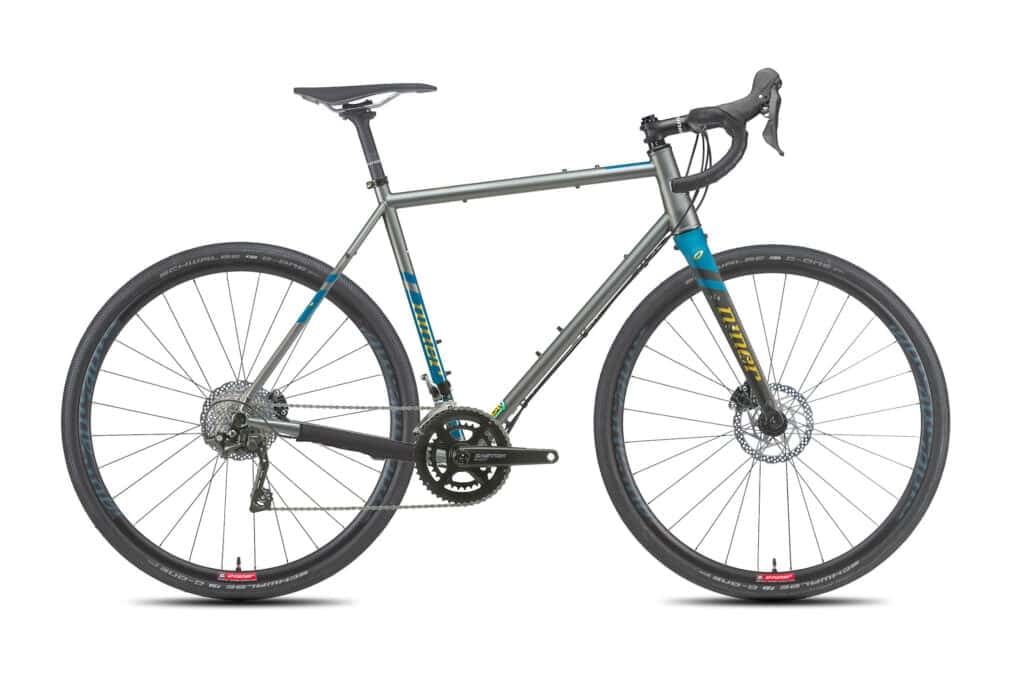
Crafted for the thrill of adventure and unparalleled flexibility, the Niner RLT 9 Steel emerges as a robust contender, featuring a high-quality Reynolds 853 Steel frame coupled with an RDO carbon fork to enhance off-road comfort.
This model introduces several significant enhancements, including an advanced carbon fork, elegantly internally routed cables, flat mount disc brakes, and additional three-pack mounts on the fork legs for extra gear.
At its core, the bike boasts a durable Reynolds 853 steel frame, perfectly complemented by Niner’s cutting-edge RDO carbon fork, ensuring generous tire clearance for both 700 x 50mm and 650b x 2.0″ tires.
A standout feature for adventurers is the bike’s extensive range of mounting options, offering up to 26 unique points for attaching racks, fenders, and bolt-on accessories, catering to every possible need on the trail.
Designed with the thrill-seekers in mind, this bike is also equipped for dropper post integration, enhancing the ride on challenging terrains.
Niner provides a variety of purchasing options for the RLT 9 Steel, ranging from a frame-only choice to a comprehensive selection of complete setups. Pricing for these configurations starts just under $3,000 and goes up to around $6,000 USD, accommodating a wide range of budgets and preferences.
More Gravel Bikes That Could Be Good Touring Bikes!
Venturing beyond the usual suspects, there exists a diverse cast of gravel bikes that double admirably as touring champions. Worth your consideration, the models listed below shine in their roles thanks to standout features such as generous tire clearance or sturdy steel frames. However, the spotlight doesn’t stop there; ensuring these bikes meet every criterion for the ultimate touring gravel bike is crucial to your script for adventure!

